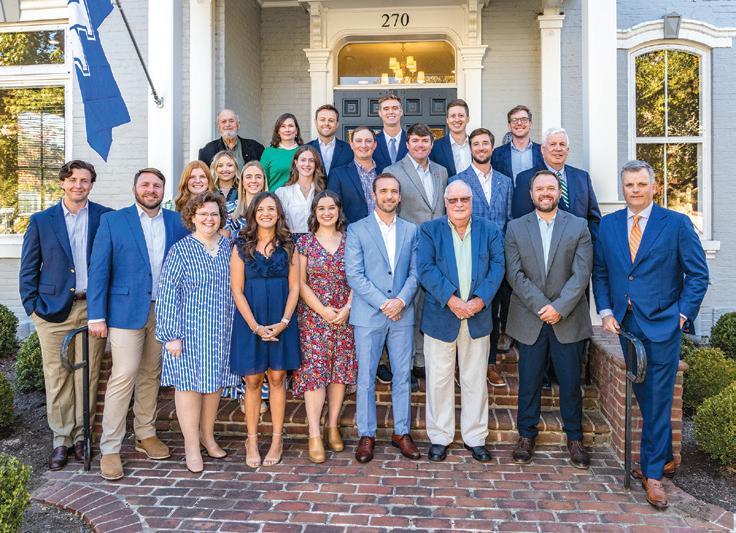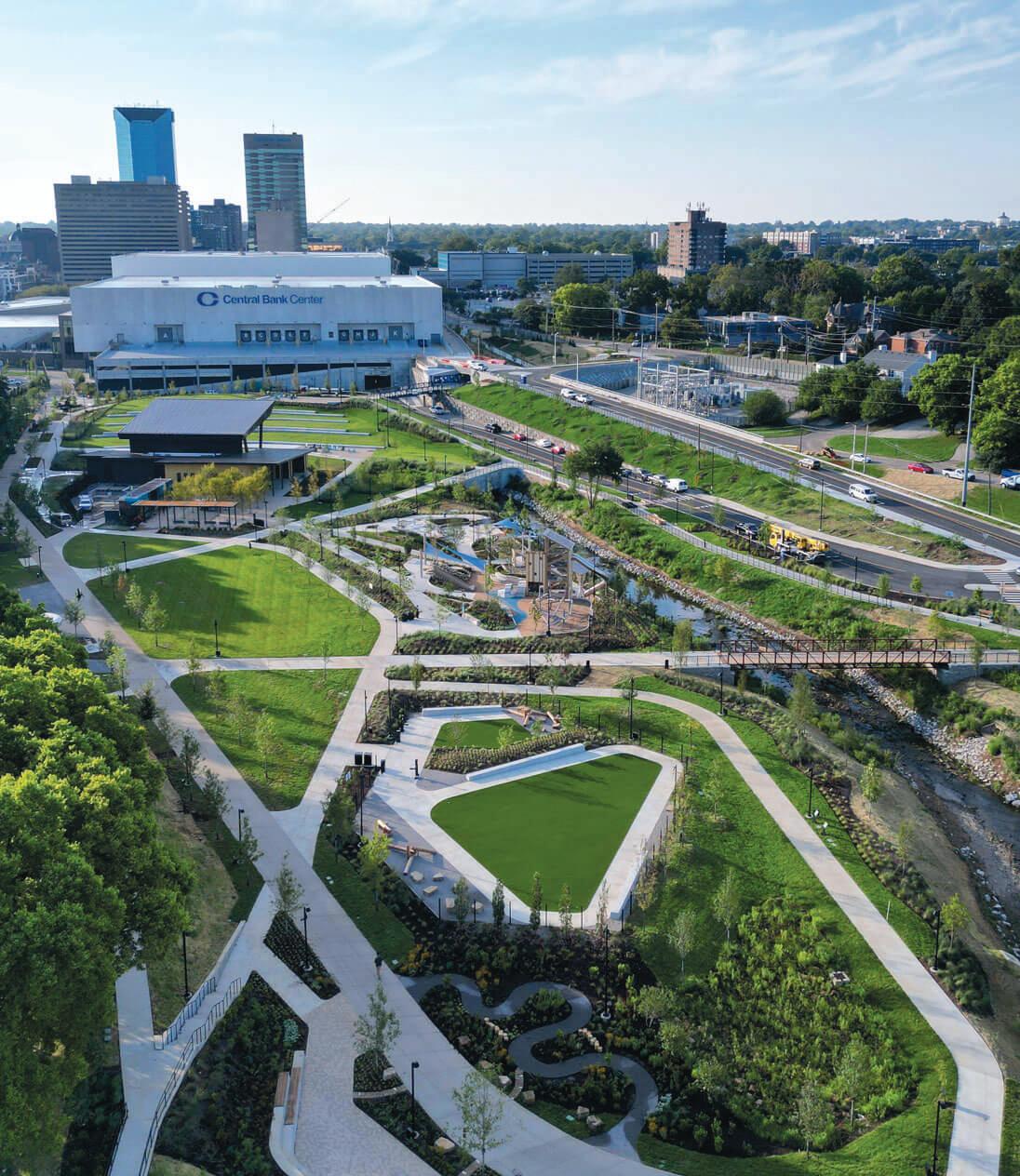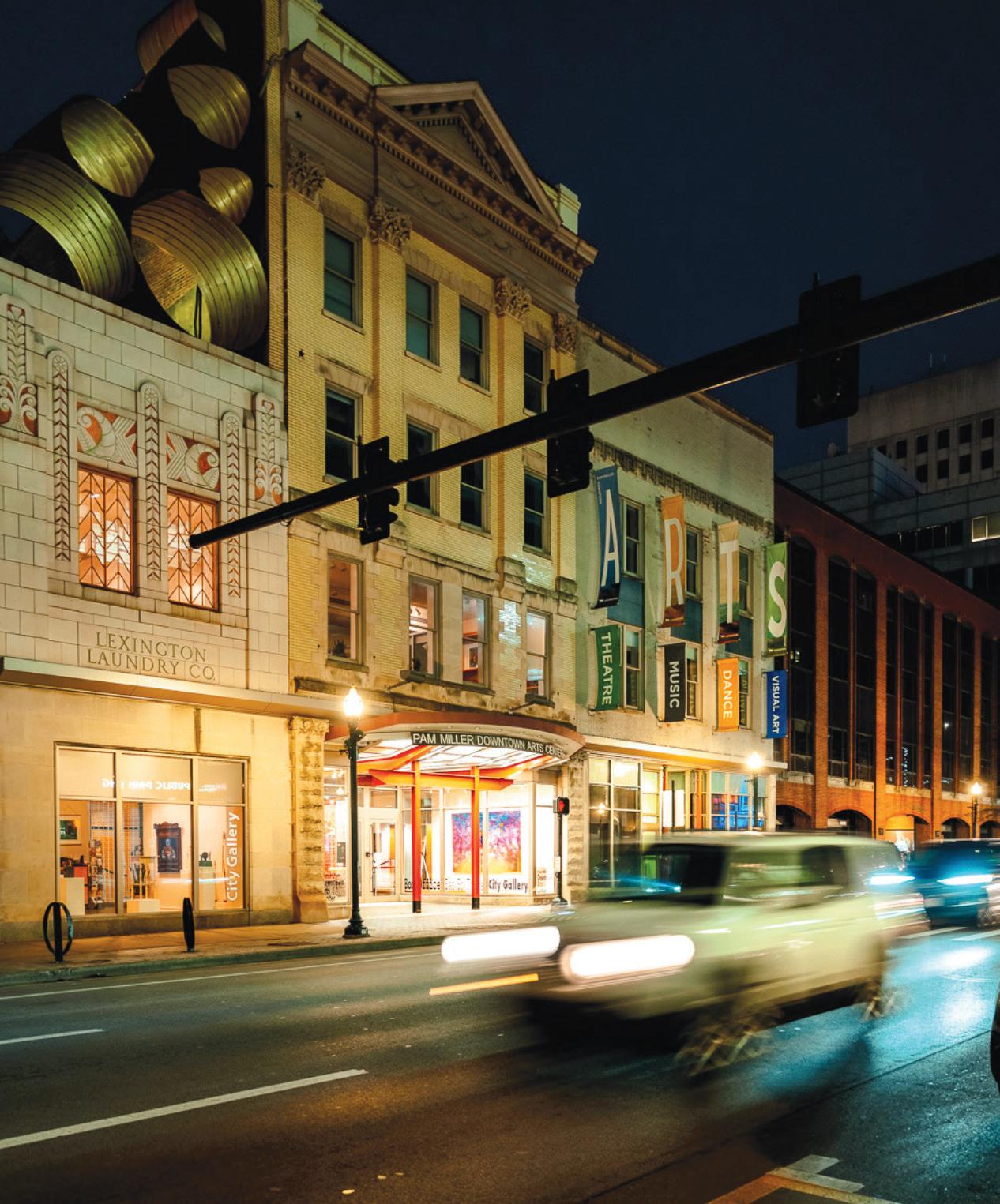
























When “Business Lexington” was founded 20 years ago, our mission was clear: to serve, inform and celebrate the local business community. A lot has changed since then — in our region, in the ways we work and in how we tell its stories. Like the businesses we cover, we’ve adapted to challenges and embraced new opportunities, evolving from a bi-weekly broadside newspaper to digital publishing to a monthly publication.
Now, with this issue, we take another step forward with a magazine-style format designed to better showcase not only the news and accomplishments of our local business community but also the personalities, insights, and even the bumps and quirks that make the Central Kentucky community what it is.
As an independently owned local publisher, Smiley Pete has always believed in reflecting and celebrating the vibrancy of our community. Alongside our sister publications, “Chevy Chaser” and “Southsider” magazines, “Business Lexington” carries that same spirit. This is not your father’s business magazine.
We also recognize that life and work are never neatly divided. What happens at the office
doesn’t always stay there, and what inspires us at home often informs the way we work. Opportunity, camaraderie, livability and community all play a role in creating balance — and that balance is part of what makes the Greater Lexington region such a remarkable place to live and work.
You’ll see this in the stories throughout this special issue. Taken together, they reflect a snapshot of the diversity, energy, and opportunity that define our region.
For those who’ve been with us throughout this 20-year journey, thank you for your continued support. For those discovering “Business Lexington” — or the Greater Lexington region itself — for the first time, welcome. We hope you enjoy what you find here.
We’d also love to hear from you. Drop us a line at info@smileypete.com to let us know what you think or with an idea for a story you’d like to see covered. We’re here to keep business news close to home — and a little more fun.
Sincerely,
Tom Wilmes, Editor
Chris Eddie, Publisher
Donna Hodsdon, Associate Publisher
A special thank you local photographers Femi Oyeniran, Bobby Shiflet Frames on Main Gallery, and the folks at Visit LEX for providing wonderful images of the region.
PUBLISHER Chris Eddie chris@bizlex.com
ASSOCIATE PUBLISHER Donna Hodsdon donna@bizlex.com
EDITOR Tom Wilmes tomw@bizlex.com
COPY EDITOR Nikole Christensen donna@bizlex.com
BIZLIST EDITOR Tanzi Merritt bizlists@bizlex.com
ART DIRECTOR Drew Purcell drew@bizlex.com
SALES MANAGER Emily Marks emily@smileypete.com
ACCOUNT EXECUTIVE Amy Eddie amy@bizlex.com
ACCOUNT EXECUTIVE Ann Staton ann@bizlex.com
(859) 266-6537
www.smileypete.com advertise@smileypete.com info@smileypete.com













































































































On behalf of the many public and private sector leaders and entities across the Greater Lexington region collaborating to enhance this special place we call home, I’m excited that we’re able to showcase some of the great things happening here and the people making it possible in this inaugural edition of Business Lexington’s Central Kentucky Regional Market Review.
While each community within our ninecounty region has its own unique characteristics, we are all striving for the same thing — economic prosperity. In today’s rapidly evolving economic landscape, it has become clear that a more unified, strategic approach is essential to keeping our region competitive on a national and global scale.
Regionalism is not a new concept, but it has become even more important in the uber-competitive global economy. That’s why, alongside regional leaders, Commerce Lexington has led the charge to develop a Regional Competitive-
ness Strategy — a bold and forward-thinking roadmap focused on seven action items designed to position our region as a destination of choice for jobs and talent, supporting a vibrant business climate.
This initiative, guided by a dedicated Regional Leadership Advisory Committee, brought together some of the nation’s foremost experts in economic and community development to evaluate global trends and assess the current state of our regional economy. Professionals in economic development and talent attraction marketing brought additional insight and firepower to this effort.
What makes this strategy unique is the depth of collaboration and input it has received. Over 1,700 surveys, dozens of focus groups, hundreds of workshops and committee meetings helped ensure the strategy reflects the needs, strengths, and aspirations of our entire region. The findings from this robust process were clear and compelling: The challenges we face don’t stop at county
lines and neither should our solutions. By working together on key economic development, talent attraction and retention and advocacy strategies, we can leverage our collective strengths, share resources, and elevate Greater Lexington as a united front in a competitive world.
We have a lot to offer here, and I hope you’ll consider Greater Lex to locate or expand your business. Our professionals across the region are ready to assist you with your site selection or expansion needs. Welcome home!
Sincerely,
Bob Quick, IOM, CCE President & CEO Commerce Lexington





Commerce Lexington is an 1,800-member organization that serves as an economic driver for the region. It is a catalyst for economic development, a convener of leaders and influencers, and a champion for a strong business climate.
Since 2021, public- and private-sector leaders from across the nine-county Greater Lexington region — Bourbon, Clark, Fayette, Franklin, Jessamine, Madison, Montgomery, Scott and Woodford counties — have collaborated on a Regional Competitiveness Strategy designed to position the region as a destination of choice for jobs, talent and investment.
Commerce Lexington manages the ongoing plan and brings together regional leaders for planning and reporting meetings, leadership and education events, and advocacy opportunities with state and federal officials.
Workforce development progress includes a new regional talent attraction website, LookAtLex.com, along with a more focused talent retention strategy and marketing campaign to raise awareness of the Greater Lexington region as a great place to live and work.
On the economic development side, Commerce Lexington team members have refreshed LocateInLex.com to focus on business recruitment, attended key events around the country to connect with companies interested in relocating to the region, engaged with site selectors, and launched a digital marketing campaign to position the region as a premier, sophisticated business hub.
u Commerce Lexington
330 E. Main St.
Lexington, KY 40507
(859) 254-4447
commercelexington.com
Although our economy has its fair share of challenges, Central Kentucky remains a resilient and growing economic force with which to be reckoned. There are exciting things happening here, and our local area governments have shown a new willingness to work together to bring them about.

James H. Frazier, III Managing Member
This cooperation has already borne fruit for our region such as the Central Kentucky Business Park Authority. This coalition of local cities and counties will attract development and create the first regional business park in the Bluegrass. Combined with other tremendous economic advances across multiple sectors, a hot housing market, and robust economic development programs, all signs point to more growth, which is no secret to those who have made this their home.
This community has been the epicenter of our law firm since 1979. Over these more than four decades, our growth at McBrayer has been driven by the growth of this market. We’re proud to be headquartered in this vibrant region, and we’ve put down deep roots here. We’ve already learned what we encourage site selectors, out-of-state entities, and even expanding local businesses to discover for themselves – the power of a united and prospering Bluegrass region.
u McBrayer
201 E. Main St., Ste. 900 Lexington, KY 40507 (859) 231-8780 mcbrayerfirm.com
At Members Heritage Credit Union, we believe banking should do more than manage money — it should empower people. Since our founding in 1960, MHCU has grown into a trusted financial partner for more than 50,000 members across Central Kentucky. As a not-for-profit cooperative, member-owned credit union, our earnings are returned to members in the form of lower loan rates, higher savings yields, and fewer fees.
We’re proud to provide a full range of financial services — from every day checking and savings to auto loans, credit cards, mortgages and business accounts — all with a focus on personalized service. We offer solutions that grow with you: digital tools to manage your money on the go, innovative card controls for security, and resources to help you plan for what’s next, whether that’s buying your first home, launching a business, or building financial stability through savings options.
Community is at the heart of who we are. Members Heritage is deeply invested in local schools, nonprofits, and initiatives that make Central Kentucky stronger. Supporting growth, opportunity, and connection is not just what we do — it’s why we exist.
Members Heritage Credit Union: Where Members Matter.
u Members Heritage Credit Union
440 Park Place Lexington, KY 40511 (859) 259-3466 mhcu.org


SVN Stone Commercial Real Estate is a full-service commercial real estate firm located in Lexington, Kentucky affiliated with the SVN International Network, which is comprised of over 2,000 advisors and staff in 200+ offices across the globe. This network offers a local, regional, national, and international platform to market properties and provide services. The SVN Stone Team consists of experienced commercial real estate advisors in the heart of the Bluegrass.
We provide commercial real estate services to large corporations, middle market businesses and individual entrepreneurial investors. Serving the Greater Lexington area, we offer advisory services for sales, leasing, management and development of commercial properties locally, regionally, and nationally. Our advisors provide creative solutions in order to help you achieve your goal. Our specialized teams can provide competent guidance to you, your clients or your investors. We have brokered, consulted, managed and provided a wide variety of real estate services across the country.
u Stone Commercial Real Estate 270 S. Limestone Lexington, KY 40508 (859) 264-0888 svnstone.com


Bourbon Community Hospital is a 58bed acute care facility located in Paris, Kentucky. Bourbon Community Hospital’s services include emergency care, diagnostic imaging, cardiology, surgery, orthopedics, outpatient therapy and more. A distinguishing feature is its behavioral health program, operating a 33-bed inpatient behavioral health unit serving both adolescents (ages 12–18) and adults.
u Bourbon Community Hospital 9 Linville Drive Paris, KY 40361
859.987.3600
bourbonhospital.com

Bluegrass Community Hospital is a critical access hospital serving Woodford and Anderson Counties. The Versailles hospital offers a broad range of inpatient surgical, emergency (24/7) and diagnostic services, as well as outpatient care such as cardiology, wound care, orthopedics, physical therapy, and primary care. The hospital is known for its comprehensive short-term inpatient rehabilitation program, also known as swing bed care.
u Blugrass Community Hospital 360 Amsden Ave. Versailles, KY 40383 859.873.3111 bluegrasscommunityhospital.com

Clark Regional Medical Center (in Winchester, Kentucky) is a 75-bed community hospital that has served east central Kentucky since 1917. Clark Regional offers emergency services, surgical and diagnostic care, cardiology, cancer care, rehabilitation, and outpatient specialties. The hospital recently expanded its Intensive Care Unit (ICU) to enhance capacity and critical care capabilities, while also operating a state-of-the-art cardiac catheterization lab that supports advanced interventional heart care close to home. Clark Regional has also been recognized for its commitment to patient safety, earning a Leapfrog “A” rating in both 2024 reporting cycles.
u Clark Regional Medical Center 175 Hospital Drive Winchester, KY 40391 (859) 745-3500 clarkregional.org

Georgetown Community Hospital is 75-bed acute care hospital located in Georgetown, Kentucky. The hospital services include inpatient, surgical, emergency (24/7), diagnostic, and specialty care such as robotic surgery and cancer care. The hospital opened a brand-new state-of-the-art medical office building in 2024 with a facility that embodies the hospital’s commitment to delivering quality care in a convenient and patient-friendly environment. The new facility is home to Georgetown Express Care, Georgetown Family Physicians, Central Kentucky Pain & Spine, and ENT Associates of Central Kentucky.
u Georgetown Community Hospital 1140 Lexington Road Georgetown, KY 40324 (859) 868-1100 georgetowncommunityhospital.com


A new competitiveness plan formalizes a long-held regional approach, aligning public and private partners around talent, infrastructure, and opportunity
TOM WILMES | BUSINESS LEXINGTON EDITOR
u A new Regional Competitiveness Strategy positions
Greater Lexington to compete with larger metros by showcasing its broad workforce and unique qualities.
by Femi Oyeniran
For decades, Central Kentucky’s leaders have recognized that individual municipalities can’t fully represent a region’s multifaceted appeal, its diverse workforce, or its economic potential. That thinking “started with Toyota landing in Georgetown [in 1985]. They were the impetus to say, ‘Listen, as a large employer, we don’t see county lines, and we’re going to need to pull workforce from a larger region than just Scott County,’” said Andi Johnson, chief policy officer at Commerce Lexington. Likewise, “if a company comes to Fayette County, the entire region benefits. So, in order to compete with those much larger million-person metros, we need to market ourselves as a region.”
Local economic development professionals and business leaders have long collaborated informally to attract companies to Central Kentucky. But in the past five years, the effort has become more intentional and strategic. In that time, public- and private-sector leaders from across the nine-county Greater Lexington Region — Bourbon, Clark, Fayette, Franklin, Jessamine, Madison, Montgomery, Scott, and Woodford counties — have worked together on a Regional Competitiveness Strategy, pooling
resources to strengthen workforce and economic development, as well as policy alignment.
Beginning in 2021 and over the course of a year, a roughly 45-member committee of business, government, education, and community leaders studied the current economic landscape compared to competitor cities and the national average, reviewed the region’s strengths and challenges, and crafted a strategy to elevate economic development. The group recognized several clear regional advantages, including: access to healthcare, a central and accessible location, relative public safety, the quality of schools and higher education institutions, a comparatively low cost of living, and an overall high quality of life.
They also identified pressing challenges, including a shortage of shovel-ready land for business development, a lack of affordable housing, insufficient skilled labor, high construction and development costs, and the reality that the region remains less well known to outside audiences.
“We did a lot of data crunching, looked at how we compared to other metros, and what we found is
“When Central Kentucky’s economy is strengthened, we all benefit. This project will provide good jobs and tax revenue that will allow the governments to make improvements.”
that on a quality-of-place standpoint, we were right behind Nashville,” Johnson said. “But when it came to some of the economic indexes, like job growth, GDP, workforce attraction — particularly with young professionals — we were below the national average.”
The group also studied peer regions such as Austin, Texas, and Raleigh, North Carolina, where business and community leaders were focused in regional efforts to support economic development and talent attraction and where Commerce Lexington has cooridnated benchmarking visits. The group also looked at comparable cities often considered by site-selection consultants and skilled workers looking to relocate, including Indianapolis, Chicago, Cincinnati, Nashville, and Knoxville, as well as competitor regions within Kentucky, particularly Louisville and Northern Kentucky.
“A common theme we noticed in communities having momentum for job or talent attraction was an intentional strategy around regionalism,” Johnson said. “Their success came from intentional collaboration between business and government leaders on infrastructure, transportation, workforce, and housing.”
Working with a consultant, the committee crafted measurables goals and identified seven action items that would be mutually beneficial to all communities. Key deliverables include the creation of the Greater Lex regional brand and increased investments in place-based marketing to external audiences, educating business and government leaders about regional priorities, developing a new talent attraction and retention website and digital marketing campaign, strengthening connections between employers and students, elevating regional economic development marketing, increasing engagement with national site selectors and key industry targets for job attraction, advocating for federal and state infrastructure investments, improving tax and regulatory policies, and addressing housing affordability.
LEXINGTON MAYOR LINDA GORTON


In 2023, more than $1 million was raised from the private sector to support the initiative, along with over $600,000 secured from local governments using a $1-per-person ratio, based on local populations. “We have almost full participation from the local governments in the nine-county region following that model,” Johnson said. Overall, the funding reflects a twoto-one ratio of business to government contributions in support of the plan’s action items.
The first visible outcome came later that year with the creation of a regional brand identity: Greater Lex – Kentucky’s Bluegrass Region. “This brand serves as the umbrella for our initiatives, unifying digital talent attraction efforts with economic development marketing,” Johnson said.
Two new websites further the effort: Look AtLex.com, which targets prospective talent through data-driven content and a digital marketing campaign aimed at alumni and frequent visitors, and LocateInLex.com, which highlights regional assets for site selectors and business decision-makers. In just six months, campaign impressions increased from 7 million to 17 million.
A talent attraction digital ad campaign launched in October 2024 and has reached more than 4 million unique impressions. Marketing focuses on “warm audiences” of alumni of the region’s 10 colleges and universities and prospective or recent tourists to the region. Content blends “live, work, and play” messaging in collaboration with Visit LEX and regional tourism and economic development partners to showcase each community’s distinct appeal. Additionally, the new economic development digital marketing campaign provides key industry leaders and national site selectors with information about the region.
“We’re giving everyone a common set of talking points,” Johnson said. “We want leaders across the nine counties to be able to share those advantages.”
Progress is tracked annually and presented at a regional summit — this year on November 12 — where leaders benchmark job growth, wage increases, GDP, digital engagement, requests for information, and site visits. Earlier this year, the Regional Competitiveness Plan earned gold in the Regional or Cross-Border Partnership category at the 2025 IEDC Excellence in Economic Development Awards, while

the Look At Lex talent website received silver recognition.
Local governments in the region are also collaborating on development projects. A notable example is the Menelaus Industrial Park, the first public, multi-county economic development initiative of its kind in Central Kentucky. The cities of Lexington and Berea, along with Madison and Scott Counties, are jointly developing a 300-acre industrial park managed by a newly created Regional Business Development Authority. The site is expected to generate 700 to 1,000 jobs when complete, with tax revenues shared among participating governments.
“Regional economic development is a winner for everyone,” said Lexington Mayor Linda Gorton in a statement about the project. “When Central Kentucky’s economy is strengthened, we all benefit. This project will provide good jobs and tax revenue that will allow the governments to make improvements.”
For Johnson, the lessons are clear: “Every community has something to offer, and the plan’s collaborative structure allows us to showcase each asset, whether it’s workforce, infrastructure, or cultural appeal,” she said. “A regional approach ensures that every county can benefit.” n

Ashley and John Backer partner with the Community Foundation to support their family giving, and Pin Oak Stud turns to BGCF to organize its corporate philanthropy.
We’re here to help with your equine, corporate or family giving. Join Ashley and John, and establish your charitable fund at the Community Foundation today.

u A Big Ass Fans employee tests one of the company’s signature industrial fans.
Bottled in Winchester for over 100 years, this gingery soda and its newer flavors started with a name that’s meant as a play on “a late one,” signaling it was the latest in soft drinks when the brand debuted in 1926. The recipe remains a closely guarded family secret.
Since 1919, this family-owned Frankfort company has produced a wide array of confections—including the original bourbon ball.
Handcrafted at this family-owned Paris company, Mingua’s beef jerky comes in a variety of bold flavors.
Nearly 600,000 Camrys were built last year at Toyota’s Georgetown plant — the largest in the world. Next up: Camry hybrids.
What kind of Japanese car do you prefer? Have a candy-induced sweet tooth? Like your peanut butter smooth or crunchy? Are you a bourbon aficionado? If so, Lexington and the rest of Central Kentucky have some locally made products you might enjoy.

This bourbon brand has grown into a global name while crafting its spirits at a historic Versailles distillery.
Originally called HVLS Fan Company, this maker of enormous industrial and commercial fans earned its now-famous name after customers kept asking, “How do I get one of those big ass fans?”
An accidental invention — a failed glue product — became one of the most clever marketing successes ever. Today, 3M produces 80 billion 3x3-inch Post-It sheets annually at its Cynthiana plant.
One of the world’s most famous peanut butter brands is made in Lexington at the largest peanut butter plant on the planet. Drive by and smell the roasting peanuts. n
From new business parks to community recreation projects, counties across the region are building a stronger economy and a higher quality of life
ALIZ CAREY | CONTRIBUTING WRITER
cross Central Kentucky, communities are
focused on growth.
Counties are investing in infrastructure, industrial parks, and recreation facilities to support economic development while improving livability for residents.
In 2021, leaders from Bourbon, Clark, Fayette, Franklin, Jessamine, Madison, Montgomery, Scott, and Woodford counties came together to launch a Regional Competitiveness Strategy designed to strengthen Central Kentucky’s position as a premier place to live and do business.
Since then, regional collaboration has fueled major joint projects—such as Fayette, Scott, and Madison counties, along with the city of Berea, partnering to develop a new 180-acre business park in Madison County under the newly formed Central Kentucky Business Park Authority. At the same time, each county continues to advance its own investments and initiatives, contributing to the region’s collective growth and vitality.

Here’s a look at some of those developments around the region:
Bourbon County has 10 major projects planned for 2025-26, ranging from the Millersburg Square Park, which will add a public park and splash pad, to a new Court Sports Complex with pickleball, tennis, and basketball courts.
Infrastructure improvements include a water line expansion, a connector road for the ParisBourbon County Industrial Park, the reconstruction of Highway 460, and the Bourbon-Nicholas County Regional Industrial Park.
New housing is on the way through the Bourbon Oaks Subdivision, which will add 120 units, and the Hotel Thoroughbred, a new boutique hotel, — will bring luxury accommodations and more rooms to the county.
Earlier this year, Winchester and Clark County officials joined Gov. Andy Beshear to announce one of the state’s largest cannabis cultivation facilities. Cresco Labs is building a $15.4 million facility expected to employ about 100 people when fully operational.
Downtown Winchester is also undergoing

improvements. The High Side Main Street renovation, which began in April and is expected to finish in November, will enhance both aesthetics and accessibility. In March, the city launched the Downtown Winchester Entertainment Destination Center, allowing visitors to purchase alcoholic beverages at participating businesses and carry them throughout downtown. Officials said the program is designed to boost local commerce and improve the visitor experience.
Fayette County is embracing growth while celebrating its history. In August, Lexington–Fayette Urban County Government opened Gatton Park on the Town Branch, transforming a former Rupp Arena parking lot into a community space with an event venue, children’s play areas, and walking trails.
Ground has also been broken on the Legacy Business Park, a 200-acre development northwest of the Coldstream Research Campus along Georgetown Road and the Legacy Trail.
Mark Turner, communications director for Commerce Lexington, said the county has seen major announcements from three biotech companies — Catalent, Piramal, and Kindeva — all of which began as University of Kentucky startups.
u Cresco Labs, a cannabis company based in Chicago, is set to build one of Kentucky's largest medical marijuana facilities in Winchester. Photo furnished by Cresco Labs
joined Gov. Beshear this year to open a Build-Ready site at Richmond Industrial Park South II. The 47-acre site features two graded building pads of 87,500 and 300,000 square feet, and is fully equipped with gas, sewer, and water lines. Officials said the development will help attract new jobs to the area.
Mercer County welcomed Earth Breeze, an eco-friendly laundry detergent manufacturer, which invested $5.9 million in an 81,000-square-foot facility expected to create 226 jobs. The county is also updating Anderson Dean Community Park and hosting festivals such as the Kentucky Heritage Jazz Festival. Local officials said they are also prioritizing new housing development.
In Franklin County, Buffalo Trace Distillery and Meridian Biotech are partnering to convert stillage — a byproduct of distillation — into alternative proteins for use in aquaculture, pet food, and fertilizer. The $40 million facility is expected to create up to 35 jobs.
Nicholasville-based Alltech is expanding its operations with a nearly $4.6 million investment, supported by $2.34 million from the U.S. Department of Agriculture’s Fertilizer Production Expansion Program. The project will establish the company’s first U.S. manufacturing plant dedicated exclusively to crop science solutions.
Jessamine County is also welcoming the state’s third Wawa store, a $7.5 million investment expected to employ about 35 people. In addition, Nicholasville-Jessamine County Parks and Recreation has unveiled an $18 million community recreation facility with spaces for basketball, volleyball, aquatics, pickleball, archery, walking groups, and more.
In addition to the regional business park project in Berea, Madison County officials
Industrial growth continues in Georgetown and Scott County. Toyota Motor Manufacturing Kentucky is investing more than $922 million in Project Maverick, a new state-of-the-art paint facility scheduled to open in 2027. The project will add 1 million square feet of capacity while reducing carbon emissions by 30% and cutting water usage by 1.5 million gallons annually.
The Scott County Fiscal Court, on behalf of the city of Georgetown, is also developing Phase III of Lanes Run Business Park. Plans include interior roadways, utility and drainage extensions, and grading to create larger sites for future tenants.
Woodford County is seeing growth in both tourism and industry, said Emily Downey, president and CEO of the Woodford County Chamber of Commerce. The Aldenberg Hotel, a 29-room boutique property with a microdistillery and steakhouse, is set to open in downtown Versailles. Highbramble Park, a new Standardbred horse training and racing facility, held its first harness race July 5.
The city also completed renovations at historic Big Spring Park. Meanwhile, new distilleries — including Bluegrass Distillers at Elkwood Farm and a brand home for True Story whiskey at the Kentucky Castle — have recently opened or are set to open soon. n
MATT
With 65% of the U.S. population within 600 miles, Central Kentucky is positioned for success. Interstate access via I-75 and I-64 carries more than 275 million tons of freight each week, while 2,600 miles of railroad track connect the region to every corner of the country. Add in record passenger traffic at Blue Grass Airport, and Lexington offers a logistical environment designed for growth.
The airport surpassed 1.5 million embarkations for the first time in 2024, fueled by a metro population now projected at 351,000 and new routes to high-demand cities including Denver, Las Vegas, New York, Sarasota, Detroit, and Chicago. Passenger numbers are expected to climb further as the airport completes a $17.8 million upgrade, scheduled for spring 2026, that will add 815 customer parking spaces, a new exit plaza, an additional covered walkway, and a separate employee lot.
“Blue Grass Airport is more than a gateway to and from Kentucky — it’s a powerful driver of jobs, tourism and economic growth for our region,” State Sen. Amanda Mays Bledsoe said in a statement. “These improvements reflect our commitment to supporting that growth, enhancing the travel experience, and keeping our airport competitive and convenient for years to come.”
The airport is also strengthening its reputation as an industry leader. Last fall, its Regional Aircraft Rescue and Firefighting Training Center unveiled upgraded aircraft and helicopter simulators to better prepare first responders for real-world scenarios.
“Our training center in Lexington brings students from all over the country — and even globally — to learn here,” said Lauren Simmerman, community relations manager for Blue Grass Airport. “In addition to that, we’ve been undergoing other modernization projects that we expect to complete in August 2025.”
That global attention extends beyond the airport. Dozens of inter-

national and domestic companies operate in the region, from Toyota (Japan), Lexmark (recently acquired by Xerox), and A&W (Singapore) to Tiffany & Co. (France) and Webasto Roof Systems (Germany).
Amazon also continues to expand its presence, marking its third decade in Lexington in 2021 by opening a second delivery and fulfillment center. The facility created more than 500 of the region’s 24,000-plus logistics jobs, further cementing the city’s role as a hub.
Fueling this economic activity is one of the nation’s most educated workforces: 20.6% of Lexington’s population holds an advanced degree, ranking 13th in the U.S. That talent pool is supported by the University of Kentucky, the state’s flagship institution and its largest employer.
Combine that with a cost of living lower than most surrounding metropolitan areas and a quality of life few places can match, and it’s clear why Central Kentucky continues to attract both businesses and residents. n


COMPILED BY
Bourbon County
Clark County
From its founding to today, Toyota’s Georgetown plant drives jobs, innovation, and economic growth in the region
LSHANNON CLINTON | CONTRIBUTING WRITER
ike a well-tuned engine optimized for peak performance, Toyota Motor Manufacturing Kentucky’s Georgetown plant and its suppliers share a carefully crafted relationship built on communication, reliability, and respect.
The symbiotic setup benefits local, regional, and state economies, providing jobs and keeping Kentucky’s auto manufacturing sector humming.
Jack Conner has served as director of the Georgetown/Scott County Chamber since 1990 and as economic development director with Scott County United, a nonprofit coordinating public and private development efforts, since 1986.
“When I came to Georgetown in 1979, a major employer, Clark, had just left the area, and the local economy was struggling,” Conner said. But a major shift was on the horizon.
In May 1986, TMMK broke ground on what would become the largest Toyota plant in the world. Two years later, it produced its first Camry. Since then, the facility has built more than 14 million vehicles and employs 9,950 full-time workers, according to its website.
The plant produces the Camry Hybrid, RAV4 Hybrid, Lexus IS 350 and 300h, and four- and six-cylinder engines. Last year, production totaled more than 435,000 vehicles.
TMMK Georgetown has also been a good neighbor, contributing more than $154 million in philanthropic and educational initiatives since opening.
As an OEM (original equipment manufacturer) TMMK works closely with about 90 manufacturers in the community. Conner said roughly 75% of those are tier one, two, or three suppliers providing raw materials, components, and parts to the plant. About 55% of all local employers are in manufacturing, making it the largest industry by employment.

Melissa Mathies, TMMK Georgetown production control senior manager, said suppliers range from two to more than 2,000 miles away. Of these, more than 440 are tier one, and 70% are located within 500 miles. Kentucky is home to 106 suppliers, employing 27,144 workers.
“Suppliers include not only vehicle parts manufacturers but also companies supporting operations, such as chemicals, steel, and waste management services,” Mathies said. “We partner with several local vendors to source essential materials and services, who in turn work with Tier 2 suppliers to provide indirect resources needed to keep our manufacturing processes running smoothly.”

In 2024, TMMK Georgetown spent $5.2 billion with Kentucky suppliers. “We primarily work with long-term suppliers who have partnered with us for many years, supporting the implementation of the Toyota Production System (TPS),” Mathies said. “These established relationships allow for greater efficiency, cost-effectiveness, and proactive risk management.”
Occasionally, new suppliers are brought in to meet evolving requirements. Toyota’s building blocks for continuous improvement — Kaizen and Respect for People — emphasize knowledge, innovative thinking, and team empowerment.
“Cohesive teams, in which each member is valued and encouraged to give their best effort, ensure our products meet customer demands,” she said.
Timely parts delivery is managed through a Just-in-Time logistics approach, leveraging real-time digital tools to connect manufacturing, sales, and suppliers. “Instead of relying on excess inventory, we focus on early risk detection and fast resolution,” Mathies said. “Clear alignment across teams enables informed decisions that keep operations running smoothly.”
Collaborative Risk Management ensures strong supplier partnerships, enabling Toyota
u Toyota’s Georgetown plant produces more than 435,000 vehicles a year, including the Camry Hybrid, RAV4 Hybrid, and Lexus IS models.
and its partners to jointly overcome disruptions. “By integrating these practices, we maintain a supply chain that’s both agile and dependable,” she said.
Part of that supply chain includes Commonwealth Tool and Machine in Georgetown. Sales manager John Traylor said the company, founded by Steve and Charlene Whitlock in 1984 as a two-person operation, has grown to a 126,000-square-foot Georgetown facility employing 50.
“We have been a supplier for Toyota since the Georgetown plant was first established— initially indirect, and then as a direct supplier

beginning in the early 1990s,” Traylor said. “Today, we support Toyota across North America, providing automated equipment ranging from lineside assembly systems to automated welding systems. While we serve other customers, Toyota has remained our largest and most consistent partner.”
Looking ahead, Project Maverick, a $922 million investment, will build a state-of-the-art paint facility scheduled to open in 2027, adding 1 million square feet while reducing water usage and carbon emissions.
“That doesn’t sound like you’re leaving; it sounds like you’re comfortable with the environment,” Conner said, reflecting on Toyota’s long-term commitment.
Last year, TMMK announced a $1.3 billion investment to manufacture a three-row battery electric SUV in 2026. State figures show
the plant has invested more than $11 billion in Kentucky since 1986.
Kristina Slattery, commissioner of the Kentucky Cabinet for Economic Development’s Department for Business and Community Development, credited former Gov. Martha Layne Collins with bringing Toyota to the state and transforming Kentucky’s approach to economic development.
“Maintaining strong connections with Toyota and their suppliers — even in Tokyo, regardless of who’s in office — has been critical,” Slattery said.
State officials focus on promoting Kentucky’s advantages while readying sites for companies to locate or expand, investing roughly $200 million in recent years to create “build ready, shovel ready” properties. Incentive tools, workforce development programs,
expedited permitting, and site preparation all help ensure speed to market.
Slattery said Toyota “really changed the way Kentucky looks,” noting that roughly 200 Japanese-owned companies now operate in the state — an indicator of confidence in the commonwealth.
Toyota also invests in workforce development through work-and-earn programs that allow students to earn associate degrees while working at the plant or other local manufacturers. A co-op program with Scott County Schools enables students to earn up to $18 an hour, reinforced by STEM learning in the classroom.
“Kentucky is proud to have Toyota as a fantastic state and local partner,” Slattery said. “We are grateful and honored that they selected Kentucky 39 years ago.” n


u UK HealthCare's Chandler Hospital is expanding with a new patient care tower adding 300 beds and expanded clinical spaces. Photo furnished

Central Kentucky’s health systems are expanding, ensuring residents have access to world-class care close to home
In Central and Eastern Kentucky, Chandler Hospital is the only Level I trauma center and the only facility in the region to offer a Level IV neonatal intensive care unit, enabling it to expertly handle severe medical emergencies and premature births. UK HealthCare also performs most of the organ transplants in Kentucky and receives the majority of complex patient transfers from other hospitals.
Expansion is underway at both Chandler and Markey hospitals. A new Chandler Hospital patient care tower will add 300 inpatient beds and expand clinical and support spaces for operating rooms, diagnostic services, labs, and a pharmacy.
“It is a critical investment in modernizing our aging healthcare infrastructure and addressing growing patient demand across Kentucky,” said Jennifer Rose, UK HealthCare senior associate vice president. “It will expand patient capacity, enhance access to high-quality care, and alleviate strain on existing resources.”
A new eight-story facility will consolidate all Markey Cancer Center outpatient clinics and oncology support services, which are currently scattered across the Chandler campus.
UK HealthCare is also in the pre-development phase on 41 acres in Hamburg, which could become a medical campus including outpatient clinics, medical offices, and potentially a regional hospital.
DAN DICKSON | CONTRIBUTING WRITER
Central Kentucky’s healthcare infrastructure is growing, giving local patients some of the best care in this part of the country. The trend is led by UK HealthCare. For nine of the past ten years, “U.S. News & World Report” has ranked the University of Kentucky Albert B. Chandler Hospital, the 569bed acute care facility in Lexington, the state’s number-one hospital, confirming UK’s statewide leadership. UK believes no resident needs to leave the state to receive advanced medical care.
“UK HealthCare, and our thousands of patient care providers, are dedicated to providing the most advanced, high-quality, and compassionate care for the citizens of the commonwealth,” said Chris Desimone, executive chief medical officer for UK HealthCare.
The UK Markey Cancer Center, part of the Chandler Hospital system, was most recently ranked 36th nationally for cancer care. It is the only National Cancer Institute-designated Comprehensive Cancer Center in Kentucky. Other specialties — including Gastroenterology, ENT, OB/GYN, Orthopedics, Neurology and Neurosurgery, Pulmonology and Lung Surgery, Geriatrics, and Urology — were designated as “High Performing” by U.S. News.
“The area in and around Hamburg, specifically the 40509 zip code, has the largest concentration of UK employees in Fayette County,” said Eric Monday, co-UK executive vice president for health affairs. “It’s one of the fastest-growing areas in the region. Our mission is to advance Kentucky in everything we do, and having a healthier state where more people have greater access to quality care and are closer to home is a critical part of that mission.”
In 2024, Baptist Health completed the largest healthcare project in Lexington in 25 years, also in Hamburg. The facility includes an emergency department, an ambulatory surgery center, cancer center, specialty clinics, and imaging and diagnostic labs. It will boost healthcare coverage across the region and relieve capacity restraints at the main Nicholasville Road hospital campus. Baptist Health is also expanding and enhancing its mother-baby unit and neonatal care center.
St. Joseph Hospital and St. Joseph East Hospital are improving and expanding services to meet growing needs. The system has modernized and expanded emergency departments, increased specialized care in cardiovascular health and oncology, and improved outpatient services.
In 2021, Lexington Clinic unveiled a larger main facility consolidating a wide range of specialties under one roof, including cardiology, dermatology, ENT/audiology, neurology, urology, rheumatology, and breast care. In May, the clinic opened a four-story Orthopedic and Neuroscience Center, combining orthopedics, neurology, neurosurgery, physical medicine and rehabilitation, pain management, and physical therapy. n
Central Kentucky’s regional and community banks go beyond loans to provide opportunities that help small businesses thrive
Local and regional banks play a vital role in a community’s economic growth, serving as a major source of small business financing, according to the Bank Policy Institute.
A 2023 study by the institute found that regional banks accounted for nearly one-third of small business bank lending nationwide. In 2022, regional banks held an estimated $169 billion in small business loans, and on average, they issued $115 in small business loans per capita.
“Small businesses often rely on banks for financing their operations, investments in equipment and technology, business expansion, and cash-flow management,” BPI said. “Access to loans, lines of credit, and other financial services provided by banks is crucial for the survival and growth of small businesses. While alternative financing sources like venture capital, crowdfunding, or peer-to-peer lending can mitigate dependence on traditional bank financing, they may not be universally accessible or affordable for all businesses.”
The study also noted that regional banks have some of the highest small business loan origination rates per capita in the South, West,
and Northeast. Their commitment to lending empowers small businesses to secure the funds needed for growth and sustainable operations.
Central Kentucky banks are no different. Regional banks in the area actively work to expand lending opportunities for small businesses in a variety of ways.
This past year, Larry Forester, senior vice president and commercial banking officer at Forcht Bank, joined Tyrone Tyra, senior vice president of community and minority business development at Commerce Lexington, to testify before the Kentucky General Assembly’s Statutory Committee Commission on Race and Access to Opportunity. They highlighted the challenges and opportunities facing minorityowned businesses in the nine-county region and discussed how the Access Loan Program, led by Commerce Lexington, is helping address those challenges. Together, the organizations are fostering an inclusive business environment that allows small businesses to thrive.
The Access Loan Program connects entrepreneurs with a network of 26 participating lenders from financial and nonprofit institutions. The program provides flexible lending
solutions tailored to small-business needs, as well as mentorship, community engagement, continued education, and other resources to support business owners and entrepreneurs. Since its inception in 2001, the program has facilitated more than $25 million in approved loans for startups and business expansions.
While national banks often grab headlines, Central Kentucky’s regional and community banks are earning recognition as well. In January, Republic Bank & Trust Company was named one of America’s Best Regional Banks by “Newsweek” and Plant-A-Insights Group.
In July, Stock Yards Bancorp, Inc., parent company of Stock Yards Bank & Trust Company — with offices in Louisville, central, eastern, and northern Kentucky, as well as Indianapolis, Indiana, and Cincinnati — received the Raymond James Community Bankers Cup for its 2024 performance. The award recognizes the top 10 percent of community banks based on profitability, operational efficiency, and balance sheet metrics.
In 2024, the bank was also named a Forbes Best-in-State Bank and a Best Bank to Work For by “American Banker.” n





Universities, technical schools, and industry partnerships are providing programs that train tomorrow’s talent
Bringing companies into Central Kentucky is about more than tax incentives and available space. Businesses need a well-trained workforce.
In the region, universities and technical schools are driving workforce development through cutting-edge research and professional training programs. This alignment of industry needs with education ensures a steady supply of talent to fuel continued economic growth.
Area colleges and technical schools are helping position the region as a hub for biotech and life sciences. In the past year and a half, announcements from local biotech companies — including Catalent, Piramal, and Kindeva, all of which began as startups at the University of Kentucky — have highlighted the region’s growth in these sectors. The University of Kentucky is also strengthening the talent pipeline for pharmaceutical sciences by expanding its degree program to address future workforce needs. Additionally, Bluegrass Community and Technical College offers the state’s only
two-year biotechnology program, further supporting the local talent pipeline.
Other initiatives, including OneUK, Connect120, and 10 Essential Skills, are helping train workers across the region. Launched in 2024, OneUK focuses on partnerships with companies statewide to create opportunities for talent development, innovation, and strategic support by aligning the university’s educational and research resources with industry leaders.
So far, the program has been a success. In its first report, released in March, the university detailed collaborative efforts among its initial cohort of business partners: Appalachian Regional Healthcare, Fischer Homes, and Valvoline Global.
“This first year has demonstrated the power of collaboration between UK and industry leaders to create meaningful impact,” said Kim Kluemper, director of the Office of Business Engagement at UK. “By working together, we are expanding opportunities for talent development, research and economic growth.”

u Students in Bluegrass Community and Technical College’s biotechnology program — Kentucky’s only two-year program of its kind — gain hands-on lab experience. Photos provided by Bluegrass Community and Technical College



Connect120 focuses on linking the university’s expertise with all 120 county extension offices to support workforce retention and recruitment. The 10 Essential Skills program works with students to develop communication, critical thinking, teamwork, and other skills essential to succeeding in today’s workplace.
At the Kentucky Community and Technical College System, workforce training reached new heights in 2024. Through its TRAINS program — a fund that helps Kentucky businesses invest in their workforce by providing customized employee training and assessment services — KCTCS partnered with companies on 339 projects, up from 248 the previous year. The system also recorded a 15% increase in new clients and a 51% increase in repeat clients.
KCTCS Vice President for Workforce and Economic Development Jessie Schook credited the growth to an additional $2 million invested by KCTCS President Ryan Quarles in the TRAINS program to meet employer demand.
“The numbers really speak for themselves for the demand within the business community for this program. We only serve a fraction of the state’s companies, but those we do serve, we serve very well,” Schook said.
Bluegrass Community and Technical College also partners with Toyota to combine work and education. Through its AMT program, employees spend two days at Toyota and three days in classes at BCTC on a campus located at the Toyota site. A partnership between Transylvania University and Appalachian Regional Healthcare allows students from Appalachia to earn scholarships to attend Transylvania and return to work for ARH. At Eastern Kentucky University, the school is working with Humana to develop a program aimed at building a more sustainable workforce.
“The competition for talent is heating up across the country, and every region is looking for an edge,” said Commerce Lexington President and CEO Bob Quick. “We are very fortunate to have so many higher education opportunities across the Greater Lexington area. Partnerships between our universities and technical schools, working closely with business, are vital to our workforce and innovation pipeline. By aligning education with industry needs, we can ensure our region develops the talent and skills that drive long-term economic growth.” n

Central Kentucky’s agriculture industry faces headwinds but leans on innovation, tradition, and technology to shape its future
LIZ
CAREY | CONTRIBUTING WRITER
Agriculture remains a cornerstone of Central Kentucky’s economy, with an outsized impact on the region’s prosperity. Yet shifting markets, trade policy, and evolving consumer demand are reshaping how the industry will grow in the years ahead.
A new study from the University of Kentucky’s Blueprint Kentucky (formerly the Community and Economic Development Initiative, or CEDIK) found agriculture’s impact on the Lexington–Fayette County economy totals more than $2.6 billion annually. The sector supports more than 16,000 jobs — about one in every 12 in the county — and generates nearly $13 million each year in occupational taxes.
“This report highlights just how deeply agriculture is woven into the economic fabric
of Lexington–Fayette County,” said Brittany Roethemeier, executive director of Fayette Alliance. “Our signature agricultural industries rely on our ‘factory floor’ — our prime soils and Bluegrass farmland. Promoting these industries, our quality of life, and our unique brand depend on sustainably growing our community and supporting innovative landuse practices.”
The number of farms in the county is also on the rise. Chauncey Morris, executive director of the Kentucky Thoroughbred Association, said farms increased from 60 to 682 over the past seven years.
Still, challenges loom. Jacob Bell, executive director of Bluegrass Ag Tech, noted that volatility in corn and soybean markets is forcing farmers to rethink their strategies.
“In Kentucky, our major commodities are corn, soybeans, and poultry,” Bell said. “In Central Kentucky, obviously the equine industry plays a giant role in our economy as well. From another livestock perspective, Kentucky is the largest beef producer east of the Mississippi. Grain commodities are in a really tough spot right now. Corn and soybeans are struggling. But beef prices are at an extremely high level. In the near term, you will continue to see an emphasis on beef production while prices and markets are strong.”
The strength of the equine and bourbon industries offers opportunities for agritourism, while the region’s robust local food movement gives farmers access to niche markets. At the same time, AgTech is emerging as a force for future growth.






“Kentucky farmers are some of the most innovative in the country, and these Challenge Grant winners highlight how new ideas and technology can create real opportunities in the marketplace.”
JOHNATHAN SHELL, KENTUCKY COMMISSIONER OF AGRICULTURE
Bluegrass AgTech recently awarded $300,000 in Challenge Grant funding to startup companies focused on transformative agriculture — projects designed to reshape the future of food, farming, and sustainability in Kentucky.
“Agriculture is a growing part of our county’s economy. A new study shows agriculture contributes $2.6 billion to our local economy each year,” said Lexington Mayor Linda Gorton in announcing the recipients. “The goal of these grants is to grow that number by producing new jobs in agtech. We want Kentucky and Lexington to become the international hub of agtech business.”
Grant winners include Kanbol Inc., which transforms corn stover, a byproduct of corn production, into compostable food containers; Orb Technologies, which produces bio-composite building blocks made from straw and grass crops; and Santerre International, which converts invasive carp into fertilizer for organic producers.
“Kentucky farmers are some of the most innovative in the country, and these Challenge Grant winners highlight how new ideas and technology can create real opportunities in the marketplace,” said Kentucky Commissioner of Agriculture Jonathan Shell. “From turning invasive species into organic fertilizer to creating sustainable packaging from farm byproducts, these companies prove that Kentucky agriculture is driving solutions for the future.”
Looking ahead, Bell said emerging technologies like artificial intelligence and machine learning may help farmers increase yields and lower costs.
“There’s obviously a market for higher-value crops that are USDA-certified organic,” he said. “If they’re able to keep costs low and production efficient, there’s an opportunity to capture higher returns for those crops.” n






u Awesome
a Lexington-based technology and entrepreneurship hub founded in 2009, supports startups with coworking space and educational programs.
furnished
From AI health solutions to bourbon flavor accelerators, Lexington startups are growing, diversifying, and making an impact
DAN DICKSON | CONTRIBUTING WRITER
Business observers are noticing that Lexington’s startup and tech ecosystems have grown significantly over the past four years. The trend, which accelerated after the COVID-19 crisis, is powered by a combination of research and development — primarily from the University of Kentucky — improved funding momentum, and strong support networks that help guide new entrepreneurs.
During this period, startups contributed nearly 14% of the area’s new jobs annually, according to real estate investing platform Roofstock.
The pace has slowed slightly in the past year, said Brian Raney, founder and CEO of Awesome Inc., which has supported small startups and individual entrepreneurs since 2009.
“That’s OK. Peaks and valleys for startups happen all the time, but luckily not as severely in Lexington,” Raney said. “Good startups still find success, raise capital, acquire new clients, and generate revenue. As long as they hit their
targets, they’re fine and can raise the rounds of capital they need.”
Lexington has a diverse economy with particular strengths in health, food, and biotech — all areas heavily supported by research from the University of Kentucky — as well as in agriculture tech, fueled by equine science and bourbon production. The city’s tech industry is growing at an annual rate of 4.1%, according to national tech school Nucamp.
“Site Selection Magazine” recently ranked the Greater Lexington region ninth for business and industry among metro areas with populations between 200,000 and 1 million. The city’s affordable cost of living further supports its entrepreneurial ecosystem.
Lexington has produced several highprofile startup success stories. Space Tango commercializes microgravity health and technology products aboard the International Space Station. Next year, the company
will conduct experiments aboard Artemis II, sending a crew around the moon for the first time since 1972. Bespoken uses hightech accelerated aging with micro-staves to replicate the flavors of well-aged bourbon in days instead of years.
Two other promising Lexington startups are drawing attention for their potential impact. Thynk Health uses AI to improve screenings and early lung-cancer detection while optimizing healthcare workflows. Parasight gives veterinarians quick in-office visual and digital analysis of animal blood, mucus, and fecal matter to identify infections and other conditions.
Other appealing Lexington startups, according to Nucamp, include Xometry, which provides on-demand manufacturing and access to a global network of manufacturing partners; Fooji, a marketing-technology company that transforms online engagement into real-world fan activation; BehaVR, which leverages virtual reality to improve mental health treatment; and PowerTech Water, which develops technologies to purify water and address the global water crisis.
Capital is the lifeblood of startups, and Awesome Inc. launched the Awesome Fund with $5 million in 2022 to support early-stage companies.
“It is a great time to have that capital and inject it into startups,” Raney said. “Most investors in our fund are former or current entrepreneurs who have had success and want to give back to the community.”
Another source of funding and mentorship is Hunsicker, a newer startup focused on launching purpose-driven companies in critical areas like health, housing, and education. Its founders aim to create solutions to some of the world’s most fundamental problems.
Lexington’s growth reflects the combination of academic research, a diverse economic base, accessible funding, and supportive networks. While the city experiences the natural ups and downs of startup activity, businesses that are well-prepared continue to succeed, raising capital, innovating, and contributing to the region’s economy. n
From tourism and talent to new parks and business opportunities, Lexington celebrates its past while shaping what’s next
ABBY LAUB | CONTRIBUTING WRITER
Lexington is in the midst of celebrating its 250th birthday, and it’s tough to imagine today’s bustling, thriving city as the small frontier town once named in honor of the Revolutionary War’s first battle in Lexington, Massachusetts.
In two and a half centuries, Lexington has grown into a highly sought-after community with signature industries that fuel a high quality of life and record-breaking tourism. In 2023 alone, visitors generated $1.6 billion in economic impact, according to convention and visitors bureau Visit LEX. That figure boosts state and local tax revenues while directly enhancing the region’s livability.
“Those record-breaking numbers are a reflection of a lot of hard work from our hospitality employees and business owners, as well as the strategic sales, marketing, services, and media efforts of the Visit LEX team,” said Visit LEX President Mary Quinn Ramer.
“Tourism supports our local businesses and attractions, strengthens our economy, and improves our quality of life.”
Living here in 2025 paints a picture of diverse opportunities, lower cost of living than the national average, safety, and ease of travel, as Lexington continues to balance heritage with new development.
The privately funded Gatton Park on the Town Branch opened downtown this year, bringing together the city’s founding waterway with modern amenities such as an amphitheater, playgrounds, dog parks, public art, and walking trails.
Less than two miles away, The Commons is transforming 42 acres of reimagined industrial land into a mixed-use district that incorporates the Distillery District and Warehouse Block. The development will feature office space, restaurants, trails, and a live music venue.

“Downtown Lexington is a place with a space for everyone to enjoy,” said Allen McDaniel, executive director of the Downtown Lexington Partnership. “With the opening of Gatton Park, the renewal of Phoenix Park, and a bustling hospitality scene, downtown is indeed the place to see and be seen.”
Mobility is also on the agenda. The Lexington-Fayette Urban County Government recently approved $250,000 for a Lextran Downtown Circulator Pilot, which would operate a trolley bus from National Avenue to the Distillery District on weekends from April through August 2026.
For visitors and residents alike, downtown serves as an anchor for shopping, dining, and

entertainment. Ample parking, valet options, and the Downtown Lexington Management District’s ambassador program — staff in bright purple shirts who keep the area safe and welcoming — make it accessible.
But Lexington is also a gateway. Ramer calls the city a hub for recreational opportunities, from canoeing on Elkhorn Creek to hiking at Raven Run or rock climbing in the Red River Gorge. Within an hour’s drive, destinations such as Cave Run Lake offer water recreation and camping.
Lexington’s quality of life is matched by its talent pool. According to Commerce Lexington, 46.5% of residents hold an advanced degree, and the city boasts an 83.8% prime-age
labor force participation rate. The region’s central location places it within 600 miles of 65% of the U.S. population.
The city consistently earns national recognition. In 2024, SmartWallet ranked Lexington No. 7 on its list of Top Cities With the Lowest Salaries Needed to Live Comfortably. That same year, “U.S. News & World Report” ranked it No. 15 among the “Best Places to Live in the U.S.,” while “Southern Living” placed it No. 10 on its “Best Cities of the South” list. “Condé Nast Traveler” also named it one of the nation’s “Top 5 Best Small Cities.”
Opportunities are keeping pace with accolades. On June 20, city leaders broke ground on the new Legacy Business Park, located near
u Home to many businesses, downtown Lexington has also become a hub for shopping, dining, and entertainment.
the Legacy Trail. The project is expected to create nearly 1,700 jobs with an annual payroll approaching $100 million.
“Legacy Business Park is the result of unprecedented collaboration among the University of Kentucky, the business community, and government,” said Bob Quick, president and CEO of Commerce Lexington. “It provides job opportunities that support our key strategic industries and existing businesses seeking to grow.”
From world-class tourism to workforce talent, parks, and business opportunities, Lexington’s 250th milestone reflects not just a history worth celebrating, but a future built on growth and livability. n

u Gatton Park on the Town Branch offers nine acres of downtown green space with walking paths, a dog park, pedestrian bridges, an amphitheater, and areas for community gatherings.
From reimagined parks to mixed-use developments and downtown revitalization, Lexington is reshaping its landscape to support growth and strengthen community
Lexington is in the midst of a major transformation, with public and commercial projects reshaping the city’s skyline and strengthening its appeal as a place to live, work, and visit. These projects reflect Lexington’s ongoing growth and aim to enhance its infrastructure, economy, and culture.
“It means excitement for the city,” said Gina Greathouse, executive vice president for economic development at Commerce Lexington. “The trend becomes fantastic data we can share with clients. I was once in a hotel room in Nashville and saw maybe 15 cranes on the skyline and thought, ‘wow.’ Recently I drove through Lexington and could see maybe seven cranes around the city. Lexington is catching up.”
One of the most visible additions is Gatton Park on the Town Branch, a nine-acre green space beside Central Bank Center and Rupp Arena. What was once acres of asphalt parking has become a downtown hub with walking paths, a dog park, pedestrian bridges, an amphitheater, and gathering spaces for community events.
“It is a quality-of-life thing, especially for recruiting talented young people,” Greathouse said. “We now have a versatile downtown park and more bike lanes.”
DAN DICKSON | CONTRIBUTING WRITER
Those bike lanes are part of Town Branch Commons, a 22-mile trail system that follows the path of Lexington’s original water source, Town Branch Creek. The Commons connects downtown to the surrounding countryside, linking urban amenities with the region’s signature rolling horse farms.
Not far away, a similarly named project, The Commons, has risen on the site of old tobacco warehouses off Leestown Road. The 42-acre mixed-use development blends retail, dining, entertainment, offices, and residences.
Its anchor tenant, RD1 Distillery, part of the Kentucky Bourbon Trail, has established an immersive brand destination featuring a tasting bar, speakeasy, and retail shop. Newly built spaces within the development are also filling quickly with additional retail and professional tenants.
Downtown, the Central Business District is poised for change. The long-empty Triangle Center, once Festival Market, is being redeveloped into a restaurant, retail, and office hub tied to an adjacent parking garage. Across High Street from Rupp Arena, a large surface lot is slated to become a mixed-use district featuring retail, restaurants, a grocery, hotel, office space, residential units, and 1,600 parking spots.
Repurposing has also come to the former
Lexington Herald-Leader building at Main and Midland, now known as The Hill. The site has been transformed into Fayette County Public Schools’ Hub for Innovative Learning & Leadership, housing merged career and technical education programs. Up to 1,500 students will train there in 39 fields ranging from advanced technology and engineering to health sciences and public services.
“The successful use of adaptive reuse and mixed-use development in Lexington and Central Kentucky allows for higher density on smaller sites while offering creative approaches to property redevelopment,” said Matt Stone, managing director of SVN Stone Commercial Real Estate.
Public spaces are also seeing civic investment. Phoenix Park at Main and Limestone is undergoing a full renovation, with new play equipment, a performance stage, adult bench swings, an improved dog park, and space for future public art. At its centerpiece will be an interactive “fog area” that combines LED lighting with a fine mist, creating a playful feature for both children and adults.
From parks and trails to mixed-use developments and educational hubs, Lexington is building with the future in mind — creating spaces that fuel growth, attract investment, and add vibrancy to everyday life. n

u Workers with God’s Pantry Food Bank deliver food in Letcher County. The nonprofit’s network of pantries and meal programs provides millions of nutritious meals across Central and Eastern Kentucky each year.
MATT WICKSTROM | CONTRIBUTING WRITER
Central Kentucky’s nonprofit community plays a vital role in supporting those who need it most, offering services ranging from housing assistance and food access to education and the arts. With one in ten private-sector Kentuckians employed by a nonprofit and over $30 billion in annual revenue, the sector is both a social and economic cornerstone of the region.
From the April opening of God’s Pantry Food Bank’s new 127,232 sq.-ft. facility on Innovation Drive and the launch of a $40 million “Building the Future, Nourishing Communities” campaign, to community foundations like the Blue Grass Community Foundation, which has awarded nearly $200 million in grants since its 1967 inception, nonprofits have long been meeting the needs of everyday Kentuckians.
Helping advocate for organizations through public policy and connecting communities to resources is the Kentucky Nonprofit Network. Founded in 2002, the collective ensures the voices of nonprofits are represented in decision-making processes.
“A lot of people don’t realize — including elected officials — the real impact of the nonprofit sector,” said Danielle Clore, CEO of the Kentucky Nonproit Network. “They may think about programs and services, which are both critical, but it’s the economic impact that benefits our communities most. All of us are impacted by the work of nonprofits daily, even if we don’t realize it.”
That impact has become even more locally focused with the launch of nonprofit coalitions serving Lexington, Louisville, and Southeastern Kentucky. The Lexington chapter was the first to open in spring 2020 in response to the COVID-19 pandemic and the urgent need to provide relief for nonprofits forced to shutter operations.
“We never did that before because we simply didn’t have the capacity to,” Clore said. “But it became clear during the pandemic with the CARES Act and the American Rescue Plan Act (and now with the state’s opioid abatement fund) that a lot of decisions were being made at the local level that deeply impacted nonprofits’ ability to serve folks in their communities.”
With nearly a quarter of the state’s nonprofits (3,337) generating over $6 billion annually, Lexington and Central Kentucky are poised to continue growing their nonprofit sector in the years ahead. Clore cites the region’s quality of life — including entertainment and dining options, outdoor getaways, and more — as a key driver.
“People want to live and work in healthy, thriving, vibrant communities, which speaks to Lexington and why it has such a strong nonprofit sector,” she says. “We also have human service organizations that deeply care about this community and partner very strongly with one another to ensure those needs are met for the betterment of Kentucky.”
But not everything comes easy for Kentucky nonprofits. In recent months, some have faced funding

“Lexington and Bluegrass-area nonprofits have a great history of working together to meet community needs, and despite the challenges, they will remain resilient.”
DANIELLE CLORE, CEO KENTUCKY NONPROFIT NETWORK
rollbacks due to federal cuts, which could have significant effects.
“Even if organizations do not receive those dollars, there’s still a ripple effect,” Clore said. “If they don’t receive those funds, then the odds are they’re fundraising to try to generate revenue to fulfill their missions, which only creates more competition. There’s real concern with regard to what funding will look like moving forward and how that will impact the people that we serve and our ability to serve them.”
“However, Lexington and Bluegrass-area nonprofits have a great history of working together to meet community needs,” she said. “Despite the challenges, they will remain resilient.” n
SHANNON CLINTON | CONTRIBUTING WRITER
Whether you’re planning a small gathering in a historic venue or hosting more than 1,000 attendees in a sleek modern facility, Lexington has a space to fit the bill — whether indoors, outdoors, or somewhere in between.
At the top of the list is the newly renovated Central Bank Center, with more than 200,000 square feet of meeting space and its adjacent 22,000-seat Rupp Arena, home to University of Kentucky basketball and year-round events.
The center includes 100,000 square feet of dedicated exhibit space, a 24,000-square-foot ballroom, and 15 breakout rooms totaling 24,000 square feet, along with another 80,000 square feet of flexible space.
Between July 2024 and June 2025, the venue hosted 225 events, drawing more than 171,000 attendees, according to Senior Convention Sales Manager Natasha Pedigo.
“What’s particularly notable is that more than 40 percent of those events averaged 500 or more attendees, and half spanned multiple days,” Pedigo said. “These figures highlight the versatility of our venue and its ability to host everything from large-scale conventions to mid-size conferences and community gatherings.”
Notable bookings include the Lexington Comic & Toy Con, ScareFest horror convention, and the upcoming Alltech ONE Conference. Lexington will also host the RCMA Emerge faith-based meeting planners event and the U.S. Sports Congress in December.
Pedigo said the city itself is a powerful draw. Located within a day’s drive of two-thirds of the U.S. population, Lexington is



venues,” she said. Fourteen local hotels also offer meeting space, several with perks like free parking and airport shuttle service.
Hotels across the city provide flexible space for events. The Bluegrass Convention Center at Clarion Hotel Conference Center features 18,000 square feet of meeting and banquet space. Griffin Gate Marriott Golf Resort & Spa, renovated in 2021, offers 29,000 square feet of meeting space and 5,000 square feet of exhibit space.
Hyatt Regency Lexington has two ballrooms among its event spaces, while The Campbell House can host up to 2,100 guests and recently unveiled a nearly 7,000-squarefoot venue called The Barn.
Newcomer The Manchester offers 7,500 square feet in its Grand Hall plus outdoor terraces and courtyards, while 21C Museum Hotel blends history and art in 7,000 square feet of gallery and meeting space inside the Fayette National Bank Building, a 15-story Beaux-Arts marvel built in 1914.
As the heart of horse country, Lexington has no shortage of distinctive event spaces tied to its equine heritage. Keeneland Race Course offers the Clubhouse and Keeneland Room for gatherings, while Alltech Arena at the Kentucky Horse Park accommodates large crowds.
Catering group Holly Hill Events operates at the Fasig-Tipton Thoroughbred Sales Center, surrounded by horse farms.

both accessible and affordable. With seven hotels within walking distance of the Central Bank Center and more than a dozen within a 15-minute drive of downtown and the airport, visitors have numerous lodging options. The city also boasts an impressive array of restaurants, shops, and entertainment.
Visit LEX plays a key role in connecting planners to venues. Vice President of Sales and Services Marci Krueger said her team assisted 270 planners last year, including 37 events at the Central Bank Center.
“The other events were hosted at various hotels, the Kentucky Horse Park, Lexington Sporting Club, on UK’s campus, and other
“Fasig-Tipton’s lushly landscaped lawns and distinctive Kentucky architecture form the perfect setting for events served up with warm Bluegrass hospitality and delicious scratch-made, Kentucky farm-fresh dishes,”
“We believe Lexington is a perfect place for a meeting.”
MARCI KRUEGER, VISIT LEX VICE PRESIDENT OF SALES AND SERVICES
said Donna Hecker, content manager for Holly Hill Events.
Other uniquely Lexington options include Apiary Fine Catering & Events — with spaces such as The Orangerie, Winter Room, and Wine Cellar — and the Kentucky Castle, where events unfold within grand ballrooms, on terraces, or in a greenhouse.
“We believe Lexington is a perfect place for a meeting,” Krueger said. “Our easy-toget-to location, affordable accommodations, and safe, welcoming environment make Lexington an appealing option for conventions and meetings of all sizes and types.” n

From long-loved institutions to buzz-worthy newcomers, Lexington’s restaurant scene blends tradition with innovation
If the Lexington dining scene could be captured on a plate, would it be a beltloosening portion of tangy, smoky barbecue? An international dish full of exciting flavors? An elegant appetizer with caviar and stunning presentation? Or maybe an inventive and modern take on Southern favorites?
Lucky for locals and visitors alike, it can be all of them, and much more.
Longtime staples anchor the scene: Columbia Steakhouse, opened in 1948, and The Merrick Inn, serving Southern classics since 1976, remain cornerstones. Bluegrass Hospitality Group’s restaurants — Drake’s, Malone’s, and Harry’s — are household names, while veteran restaurateur Kuni Toyoda has shaped the market with Smashing Tomato, Bella Notte, Crust and, more recently, Bella Cafe’s two locations.
Newcomers are adding fresh flavor to the mix. The Obstinate Sons, co-owned by Dexter Murray and Cannon Applegate, reflects decades of culinary experience and a commitment to reinvention. “Some ideas are home runs, others are swings and misses,” Murray said. “The exciting part is reimagining classics and seeing what resonates with our guests.”
Purple Yum Bakery Café, which opened in March, brings a taste of Asian bakery culture to Lexington. Owner Cai Dong has quickly won fans with coconut cream buns, moon cakes, and

“Everybody understands that rising tides lifts all boats and everyone can win.”
DALLAS ROSE, MILETA MANAGING PARTNER AND PROPRIETOR
delicate strawberry crêpe cakes layered with whipped cream. “People are creatures of habit, but always want something different,” Dong said. “Mostly it’s been a good experience for people, especially kids, to try something new.”
At J. Render’s Southern Table & Bar, what began as a food truck in 2012 has become a beloved restaurant serving fried chicken, smoked wings, and favorites like deep-fried ribs and fried green tomato sandwiches. “Our recipe for success has been cooking what we know with family recipes while also being inventive,” said owner Gwyn Everly. “We also believe that giving back is very important, and we strive to do that in our community.”
Mileta, a modern Italian-inspired kitchen that opened at Fayette Mall in late 2024, highlights handmade pastas, tomahawk steaks, and poached halibut with farmer’s market vegetables. For proprietor Dallas Rose, the restaurant business is about being an “ambassador of culture” and helping to push Lexington’s food scene forward. “Everybody understands that rising tides lift all boats and everyone can win,” he said.
With steady support from a growing population, the University of Kentucky, bourbon tourism, and horse racing events, Lexington’s restaurant scene is thriving. From cherished institutions to fresh culinary voices, the city continues to set the table for memorable meals. n

With new venues, public art, and cultural investment taking shape, Lexington is strengthening its reputation as a creative hub
MATT WICKSTROM | CONTRIBUTING WRITER
Lexington has long been a creative hub in Central Kentucky, home to a thriving community of writers, visual artists, musicians, and performers. The arts here aren’t just cultural cornerstones — they’re economic drivers, supporting more than 1,100 full-time jobs and generating $32 million annually.
That influence continues to grow. From the August 2024 opening of Gatton Park on the Town Branch to the expanding Distillery District, new state tax incentives attracting the film industry, and the unveiling of an Underground Railroad monument on the city’s east end, Lexington’s creative sector is more active than ever.
One of the most ambitious recent projects is the new 14,000-squarefoot headquarters for the Lexington Theatre Company, which celebrated its grand opening in February 2024. The space brings under one roof everything from rehearsal halls and classrooms for its artist development program to administrative offices, a scene shop, and a costume shop.
“It’s allowed us to pull everything and everyone under one roof, which has been absolutely game changing for us,” said co-founder and artistic director Lyndy Franklin Smith. Plans for the facility include a 120seat black box theater and cocktail and concessions stand, adding to the company’s already robust programming at the Lexington Opera House.
Franklin Smith, who grew up in Lexington, has long envisioned her
hometown as a theatrical destination. Since she and her husband, Jeromy Smith, founded the Lexington Theatre Company in 2015, the organization has welcomed both local students and nationally known Broadway talent. The momentum, she said, has helped generate a buzz that draws more and more creative professionals to Lexington.
“They love the beauty. They love the hospitality. They fall in love with the charm of Lexington and it quickly starts to become a second home for them,” Franklin Smith said.
That mix of culture, community, and opportunity makes Lexington increasingly attractive, said Nathan Zamarron, vice president of LexArts. The city’s location adds to its appeal, as it’s within a few hours of major creative hubs like Louisville, Cincinnati, Indianapolis, and Nashville, yet offers a fraction of their cost of living.
“Not only do you get to experience four distinct seasons during the year, but you can also be in Atlanta in six hours or a number of other cities in even less time than that,” Zamarron said. “That’s why we had such a jazz infusion in the ‘40s and ‘50s — Lexington was on the way to everywhere. But now instead of just stopping through, you’re starting to see more and more creatives settling down here as well.”
With new investments, dedicated venues, and a welcoming spirit, Lexington is proving itself as a city where creativity thrives, and where the arts will play an even larger role in shaping what comes next. n


u A climber tackles a route at LEF Climbing Gym on North Broadway, one of many venues both indoors and out offering active pursuits for Lexington residents. Photo furnished
From paddling to pickleball, running, cycling, and climbing, Lexington offers year-round sports and recreation for every age
ABBY LAUB | CONTRIBUTING WRITER
Lexington may be known for horse racing, bourbon, downtown dining, or Big Blue Nation fanatics, but whether you’re age 7 or 75, it’s hard to imagine a perfect Central Kentucky weekend without participating in sports or recreational activities.
Start your Saturday with a calm morning paddle on the Kentucky River from Kelley’s Landing — Lexington’s first and only public access on the scenic river, with stunning views of the dramatic palisades. Then meet friends for pickleball at the 20 brand-new courts at Shillito Park, barely a 20-minute drive away. Tennis players aren’t left out either, as the park also features eight new tennis courts.
Pickleball has exploded in popularity, drawing players of all ages. Public courts are free, and clubs like Pickleball Paddock and Pickleball Kingdom offer more options. On any given morning, you might see toddlers cheering from the sidelines while adults old enough to be their great-grandparents compete with friends.
“I love pickleball because anyone can play regardless of age or skill level,” said Kristin Ray, an agent with Lexington-based LifStyl
Real Estate and coach at Lexington Athletic Club. “It’s a great way to have fun, get exercise and engage your brain in a way we don’t in our normal day-to-day activities.”
Lexington’s recreational options continue to grow. When complete, the 30-acre Kelley’s Landing will include walking trails along the river, recreational and educational activities, and a playground.
“Over the past few years, Lexington has seen many investments and enhancements to our parks,” said Councilmember Kathy Plomin in a statement about the project. “Kelley’s Landing will provide direct access to the Kentucky River and allow new and unique outdoor recreational uses. Kelley’s Landing is a welcome addition to our city and region.”
The weekend doesn’t stop there. Youth soccer leagues abound, providing endless opportunities for families and spectators alike. Unique classes at places like LEF Climbing Gym on North Broadway offer residents the chance to try new sports — and earn bragging rights.
Cycling enthusiasts can enjoy the rolling hills and horse farms surrounding Lexington, or take advantage of the Legacy Trail, a 12-mile
shared-use greenway connecting downtown with the Kentucky Horse Park. The trail accommodates cyclists, rollerbladers, and walkers of all skill levels.
Running is also thriving in Central Kentucky. Bob Baney, owner of RaceRise, has directed thousands of races and says the industry has grown significantly over the last decade.
“Anymore, you can pretty much take your pick of two to three races per weekend in Central Kentucky,” he said. “There are everything from 1-milers to 3Ks, the popular 5K, 10K, half marathon and full marathon. Trail running has also become very popular in Lexington, Georgetown, Berea, Frankfort and the Red River Gorge area.”
Baney notes that specialty run/walk shops and social race atmospheres contribute to the sport’s growth, encouraging first-timers to join for free.
“These races not only are great for keeping our citizens healthy but most every one of them supports a local charity, so there is a positive ‘give back’ made with every person who registers,” Baney said.
In Lexington, the only limit for recreational and sporting enthusiasts is imagination. So, whether you’re cheering from the sidelines or taking the lead, get out there and get moving. n

u Runners compete in a RaceRise event in Central Kentucky, where the growing running scene now offers multiple events nearly every weekend. Photo furnished by RaceRise
1 2 3 4 5 6 7 8 9
Commerce Lexington
330 E. Main St., Ste. 100 Lexington, KY 40507 (859) 254-4447 commercelexington.com
Georgetown/Scott County Chamber of Commerce
160 E. Main St. Georgetown, KY 40324 (502) 863-5424 gtown.org
Richmond Chamber of Commerce*
201 E. Main St. Richmond, KY 40475 (859) 623-1720 richmondchamber.com
Mercer County Chamber of Commerce
101 S. Main St., Ste. 1 Harrodsburg, KY 40330 (859) 734-2365 mercerchamber.com
Mt. Sterling - Montgomery County Chamber of Commerce
124 N. Maysville St. Mt. Sterling, KY 40353 (859) 498-5345 mtsterlingchamber.com
Winchester-Clark County Chamber of Commerce 61 S. Main St. Winchester, KY 40391 (859) 744-6420 winchesterkychamber.com
Woodford County Chamber of Commerce
126 S. Main St. Versailles, KY 40383 (859) 873-5122 woodfordcountyinfo.com
Jessamine Chamber of Commerce* 116 S. Main St. Nicholasville, KY 40356 (859) 877-4351 jessaminechamber.org
Lawrenceburg - Anderson County Chamber of Commerce 1388 Bypass North Lawrenceburg, KY 40342 (502) 839-5564 andersonchamberky.org
Annual Events/ State and National Recognitions
2022: Dr. Martin Luther King, Jr., Award from the Alpha Beta Lambda Chapter Education Foundation of the Alpha Phi Alpha Fraternity; 2021: Mac Conway Award for Excellence in Economic Development (Site Selection Magazine) and more.
Annual Awards Celebration, Annual Golf Outing
Executive Director
Taste of Richmond, Pops at the Park, City Fest at EKU, Richmond Restaurant Week, Annual Business on the Greens Golf Tournament
Pioneer Days Festival, Kentucky Heritage Jazz Festival, Small Business Saturday, Farm City Celebration, Earth Day Clean-Up; Have received more than 17 state recognitions for communications and events.
Annual Chamber of Commerce Awards Banquet, Golf Scramble, Membership Breakfast and Luncheons, First Responders Appreciation Cookout, Keeneland Outing, Christmas Parade
Beer Cheese Food Week, Leadership WinchesterClark County, Annual Chamber Member Awards Banquet, Golf Scramble
Chamber Golf Scramble, Twilight Festival, Red Tie Gala, Santa Shuffle 5K, Woodford Night Market, Women’s Conference
Awards Dinner, KY Wine & Vine Festival, Golf Scramble, Taste of Jessamine
Annual Golf Classic, Longest Day of Play, Annual Gala, Elevate, Annual Sip & Stroll; Kentucky Chamber of Commerce Executive Awward: Excellence in Membership Growth 2020; Kentucky Chamber of Commerce Executive Award: Excellence in Social Media 2020
Paris-Bourbon County Chamber of Commerce 806 Main St. Paris, KY 40361 (859) 987-3205 parisbourbonchamber.com
Cynthiana-Harrison County Chamber of Commerce
141 E. Pike St., Ste. 3 Cynthiana, KY 41031 (859) 234-5236 cynthianakychamber.com
Berea Chamber of Commerce* 424-B Chestnut St. Berea, KY 40403 (859) 986-9760 bereachamber.com
Danville - Boyle County Chamber of Commerce
105 E. Walnut St. Danville, KY 40422 (859) 236-2361, ext. 120 danvilleboylechamber.com
Scramble, Best of Bourbon County Chamber Gala and Awards Dinner, Bluegrass Hearing Clinic Festival on Fifth Summer Concert Series, local elected officials breakfast, legislative update from state officials, Chamber of Commerce Christmas Parade; KCCE Pivot Award, KCCE Young Professionals of the Year
Director named in 40 Under 40 in the Chamber Industry by AACE
Spring and Fall Golf Scrambles, Spoonbread Festival, Geocaching Weekend, Spring and Fall Rook Tournament, Christmas Parade, Spring and Fall 5K

The November 2025 issue of Business Lexington will focus on the business of modern health care and feature the following BizLists: Regional Hospitals, Health Care Law Firms, and Concierge Medical Practices.
Ad space deadline: OCT 21 | Ad materials deadline: OCT 23
Advertising info: (859) 266-6537 or email advertise@smileypete.com








